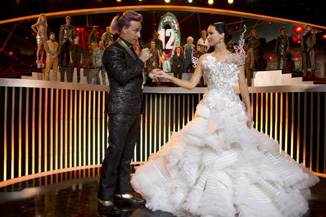|
|
Book vs. Movie: Catching FireBy Ben GruchowNovember 4, 2015
The movie retains most of the book’s attitude toward violence and death; indeed, turning the satire into something mostly implied emphasizes the humanism on display, and the sequence with Effie is one of three passages in the film that are surprisingly moving. All three, in both book and movie, involve the affirmation of both empathy and grief - but the movie expresses them with more clarity and directness, and there are case studies in each of them of how slight changes in wording and incident from one medium to another can communicate very different levels of urgency. The Verdict About a half-hour into The Hunger Games: Catching Fire, Katniss delivers a eulogy to the character Rue from the first installment. This eulogy is expressed in rather academic terms in the novel, and much more informally in the film. The depiction of Rue’s family during this sequence is done with a visual pragmatism that’s a little discomfiting, and commendable for it; Rue’s actual death in the first film was pretty sanitized, and the grisliness of it was redirected into a short, safer seed-of-rebellion sequence. And in the novel of Catching Fire, Katniss is moved to eulogize Rue at least partly by the perception that one of the deceased’s siblings is silently imploring her to do so. Here, she faces not Rue’s sister but a giant video image of Rue herself, with her survivors positioned beneath, and the blunt and straightforward way the family is clearly staged for the benefit of a narrative moment gives the setting a ghastliness and sick plausibility that is nearly all by itself more potent than anything thus far in the book (and, for that matter, anything in the first film).
|

|
|
|

|
Wednesday, May 1, 2024
© 2024 Box Office Prophets, a division of One Of Us, Inc.


